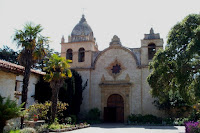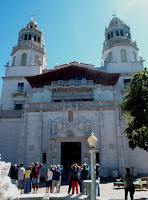Monterey is a city located on a sweeping bay about 2 hours drive south of San Francisco.
These pages show photos of our trips in and around Monterey:
Monterey and the Monterey Bay Aquarium
Monterey's attractions stem from its:
- history as the Californian capital under the Spanish and Mexican flags
- time as a major sardine producer
- protected, Marine Park status
- associations with the authors Robert Louis Stevenson and John Steinbeck
One of its major attractions is Cannery Row, an area described in John Steinbeck's novel of the same name. Originally
a street of sardine canning factories, Cannery Row is now home to many souvenir shops and restaurants.
Another major attraction is the Monterey Bay Aquarium, also a former cannery. Monterey Bay is a protected Marine
Reserve and, from the shoreline, you can spy sea lions lazing on open rocks, sea otters playing amongst the kelp and
sea birds perching on walls and rocks.
Monterey is located on the rim of a deep, undersea canyon. The Monterey Bay Aquarium includes exhibits of marine life
from different habitats around the bay, and has two three-storey displays showing life in a kelp forest and in the
deep ocean.
This display shows the Green Anemone (one of the largest anemones in the world), sea lettuce and other fish and
plants. There were so many animals displayed that we didn't note all their names.
The Aquarium has special exhibitions that change regularly. The newest exhibition was titled: "Jellies: Living Art".
This exhibition displayed jellyfish as living paintings in an art gallery. Jellyfish swam in tanks with contrasting
backgrounds and glass beads, display glass was surrounded by ornate frames, and the tanks were softly lit.
This "painting" contained sea nettles.
Another "painting" highlighted the opaqueness of this jellyfish.
The "living paintings" were displayed alongside other forms of art inspired by the jellyfish, for example dance
videos, lamps and these glass sculptures.
Back to top
17-Mile Drive
The 17-Mile Drive is a private toll road through the Monterey Peninsula. It includes breathtaking views of the
coast, Pebble Beach and the San Carlos Borromeo de Carmelo Mission, better known as the Carmel Mission.
Cypress trees grow in abundance along the coastline of the Monterey Peninsula. These hardy trees thrive on sandy,
rocky shores and are shaped by the wind blowing salt water in from the sea.
This photo depicts the Lone Cypress, a tree that has become the (trademarked) symbol of the Pebble Beach community.
Cypress trees usually last about 300 or 400 years, not a particularly long lifespan compared to some other varieties.
The Lone Cypress is unlikely to survive more than about another 40 years, and even now guide ropes are set up to
stabilise it.
There are four world-class golf courses along the 17-Mile Drive, the most renowned being Pebble Beach. This photo
shows the 18th hole of the course.
This is Pebble Beach Lodge, built in 1919 by the son(?) of Samuel Morse, inventor of the telegraph. Samuel Morse's
son was responsible for conserving much of the natural beauty around Pebble Beach.
The Carmel Mission was the second mission established in California by Father Junipero Serra, a Franciscan monk. This
mission was used as the administrative headquarters for the 21 missions set up by the Franciscan monks along the
coast of California.
Originally, the mission was set up in Monterey (only a block from our hotel!) but Father Serra abandoned the mission
there after a year because of its proximity to the Presidio (the army).
Carmel Mission is where Father Serra spent most of his life after setting up the missions. He is buried beneath the
altar in the chapel.
Back to top
Big Sur
El Grande Sur, literally "The Big South", refers to the 90-100 miles of coastline south of the Monterey
Peninsula. Most of this country is preserved in its natural state and there are few homes or settlements.
Highway 1 winds its way down the coast, hugging the rim where the mountains drop into the sea and crossing deep,
narrow ravines.
There are official (and unofficial) lookouts all along the highway. We hired a car to drive down the coast - it is
really the best way to explore this area.
The weather was strange. We kept driving in and out of a fog rolling in from the sea.
We stopped for lunch at Julia Pfeiffer-Burns State Park. Here, McWay Creek falls 100m into the sea. This is the only
waterfall of this type on the west coast.
This is Big Creek Bridge. Many similar bridges were built in the 1930s to cross ravines. At the time, the Bixby Creek
Bridge - a bridge similar to this one - was the world's largest single-arch bridge.
Six miles (about 10km) before San Simeon is Point Piedras Blancas. Tony and I stopped to view the coastline and
discovered that an elephant seal colony inhabited the beach.
At this time of the year most of the elephant seals are moulting "weaners" (pups that have been weaned). By the end
of March, most of the male elephants seals have returned to the sea. The females moult and then return to the sea in
April.
Back to top
Hearst Castle
Hearst Castle was the dream of millionaire, William Randolph Hearst. The castle and its guesthouses were designed by
Julia Morgan, the first female Californian architect. There are European, ancient Greek and Roman influences.
This outdoor pool is called the "Neptune Pool". At one end of the pool is this Greek temple flanked by two covered
walkways supported by similar columns. Opposite the temple was a terraced fountain with marble statues.
The castle buildings and grounds were designed around a Spanish village. The main house, Casa Grande, was the
cathedral in the centre of the village.
Hearst was continually demanding changes to the plans and, as a result, parts of buildings were constantly being
knocked down to incorporate changes. The original plan for Casa Grande comprised a single bell tower and around 90
rooms. A second bell tower was added later and the final building has 115 rooms.
The house contains many antiques and reproductions. The "Ceiling of Saints" in the Refectory are life-size, wooden
panels from a medieval Italian church. The flags are banners representing different districts in Sienna, Italy.
The Roman Pool is an indoor pool. Its design comprises mosaic tiles fused with gold for the walls and floors and for
the pool itself.
Back to top
Morro Bay
From Hearst Castle we continued down the coast highway to San Luis Obispo and then headed back to Monterey via the
Interstate highway. On our way we stopped at Morro Bay for lunch.
This distinctive rock gives Morro Bay its name. The rock was named "El Moro" (The Moor) by a Spanish explorer because
it reminded him of a Moor's hat.
Back to top




















No comments:
Post a Comment
Comments for posts older than 14 days will not be immediately displayed. We review these comments before publishing them for public display.